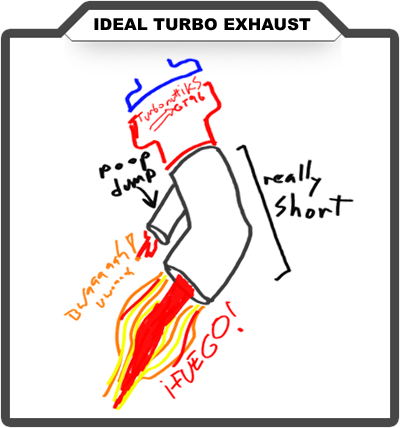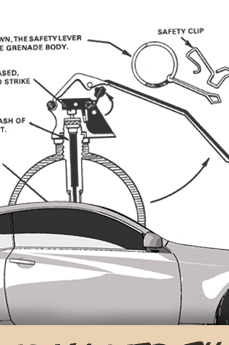For the turbo car, one word essentially sums up this section. However, because you people are so fashionable, and just GOT to keep up with the Joneses, we're going to cover the functionality first, and the fashion second. Yes, the quintessential "Which exhaust sounds AWESOME on my car?" quesition will be addressed. But its the only time I'm going to indulge such an imbecilic question.
Turbocharger Exhaust Theory & Scientific Application
Bobby is back from Elementary School, and he's gonna give you a hand illustrating the complex science and thermodynamics behind answering the age-old question "how do I make more horsepowers with an aftermarket exhaust on my super spinny turbine equipped automobile?" There is one way, and one way only to help your turbo make the most power it can, and spool as quickly as possible, with an aftermarket exhaust.

As you can see by our quality technical illustration, turbochargers really hate backpressure. This means the longer your exhaust tract is from the hot side of the turbo back, the more backpressure is resisting the inducer housing/wheel from letting the holy shit hot exhaust and waste gasses exit the housing and wastegate. Think of it as seriously painful, Dark Side Level Constipation. If you can't get that shit out, you just don't perform very well. Face it, you won't score very highly in track & field with a ton of shit backed up in your large intestine, you're going to be shoving Pepto and coffee down at alarming rates instead.
If your turbocharger's inducer wheel, however, sees as wide open an exhaust tract as possible - with as little restriction as possible - that turbo is unshackled, able to jaunt and skip cheerfully across the gilded meadows of freedom. This is good.
Therefore a couple points come to mind -
- A straight dump pipe and separate exhaust pipe, as large in diameter as possible, as short as possible, favor best performance, period, end of story.
- A recirculated (the wastegate dump goes back into the primary exhaust pipe) fullback exhaust with a single exit, as large a diameter as possible, is the best possible blend of legal compliance (full cat-back exhaust) and low restriction.
- A dual-exit exhaust (most brands offered on the car) still offer slight power gain but are not the best possible situation if you're going for POWAAAAAH.
NOTE: Titanium exhausts exist on the market; why should you spend the extra money?
Answer: You shouldn't. You are throwing your money away. Titanium saves you maybe 10-15lbs vs another exhaust. This is indeed a weigh savings, but kiddo, you're going to need to drop a helluva lot more than ten pounds to see a difference in power/weight ratio performance.
Brands Available
With exhausts, again, shop from the reseller/distributor of your choice. Exhaust for a turbo car is a painfully simple science as far as who/what offers best performance. Shortest run, largest diameter pipe, period. Get the exhaust gas out YESTERDAY.
Typically, drivers report the following, with many of the popular brands, though more exist -
Magnaflow - excellent sound, medium/"good" noise level
AEM - nice sound, little on the quiet side
Injen - Is your car even on? I can't tell.
ARK GRIP - One of the biggest wastes of money this side of Capitol Hill. Looks pretty; the "secondary chambers" on the exhaust cans do precisely dick despite what ARK tells you about it's "research & development". Also hangs so low it's likely to pick up small plants and animals while driving.
MXP - DEAR GOD TURN THAT SHIT OFF I CAN HEAR IT IN THE NEXT STATE
Beyond Redline - good sound, little loud for some but acceptable for most
Tsudo - Meh, you get what you pay for. Not terrible, not awesome.
Any Single-Exit - Announces your presence just about anywhere; the only choice for old school import enthusiasts
HKS Legamax - How awesome do you feel now that you are like... $1200 in the hole for 8hp?
Greddy Ti-C - Only fashionistas need apply. Can do the same for half the price performance-wise.
CP-E - See above.
Sterlin F1 Variable Exhaust - Holy moley expensive. Features a variable valve cutoff to quiet the exhaust at will. Exhaust cutoffs have been popular for decades with tuners of all types because the diverter valve which pushes exhaust flow through either a quieter pipe run or a fullback loud run allows you to technically have your cake and eat it too, and not attract unwanted attention. Be warned; movable electrical devices that sit in extremely hot exhaust gasses for long periods of time tend to fail and stick shut or open at very inconvenient times. Use with care.
The Exhaust Shop Route
Any exhaust shop can bend you up a custom exhaust for literally a fraction of the price you'd pay for a brand-name cat-back or turbo-back exhaust. Bear this in mind; an exhaust shop typically is unable to fab you a turbo-back exhaust because they will need flanges for the turbo hotside, etc. But as far as cat backs go (because you can easily purchase a 3" O2 pipe) you can have a full 3" all the way back exhaust fabbed for chump change and sound & perform as well as any $1000 brand name catback.
Open Dump Pipes on the Street
If you so choose to run an open dump pipe off your (larger, aftermarket) turbo's wastegate, know this: You WILL attract every cop's attention, very quickly. When you let off the throttle, your ECU throws fuel through the motor to cool it, especially so after the motor has been run hard. After running, your dump pipe will have sounded really awesome - but it's extremely hot. This means when you freak out and pull your foot off the throttle to jam on the brakes, your dump pipe will be dropping extremely loud grenades beneath your car for the whole world to hear; and if it's dark, bright flashes of combusting fuel will be visible beneath the car, or out the pipe if it's visible off the car. Now, typically this is considered fun and cool, but in states like California, New Jersey, Virginia, Washington DC, New York, Chicago, pretty much any metro area - think twice before you do this on the street; in California a car with an open dump can be immediately impounded for CARB & gross emissions violations on-sight if a law enforcement officer feels like doing the paperwork, do not pass go, go directly to tow truck. This typically means a ref ticket as well; you will get to go to court and spend a bunch of money paying fines and putting the car back to stock.
Therefore - either knuckle up and be prepared for this eventuality and drive accordingly - or run a recirculated exhaust on the street so as to avoid attention from law enforcement. In states with loose/no emissions control, nobody really gives a damn but the noise is sure to attract attention regardless.
Downpipes, O2 Housings & Test Pipes
Quick and dirty - if you are sticking with a stock turbo on either generation turbo, do yourself a favor and buy an O2 pipe, downpipe and test pipe from pretty much anyone. Buy the one you can afford, they are all pipe-like objects that allow hot smelly gas to pass through them, so they will all work. This is the quickest and cheapest way to free up noticable power on a stock turbo car, period.
Despite what anyone may tell you, no one brand performs above any other; this is a rudimentary part.
O2 Simulators to avoid CEL: This is known to work from time to time; a couple brands advertise an "O2 simulator" to fake the secondary O2 sensor into seeing enough of a gas oxygenation difference to not throw a CEL. This can also be achieved in some cases by using a sparkplug defouler fitting in the O2 bung, and is generally considered a redneck fix. The only right and proper way to eliminate your CEL with a straight O2 housing is to purchase a canned tune that eliminates the O2 CEL, most of the Korean suppliers claim to fix it, though that claim so far doesn't have a totally solid batting average depending on whose tunes you buy.
The reason these pipes free up power is what was discussed using our Crayon-infused technical drawings - removing the catalytic converters and upping the pipe diameter form the turbo back means less backpressure on the turbo, which is good for everyone.

































